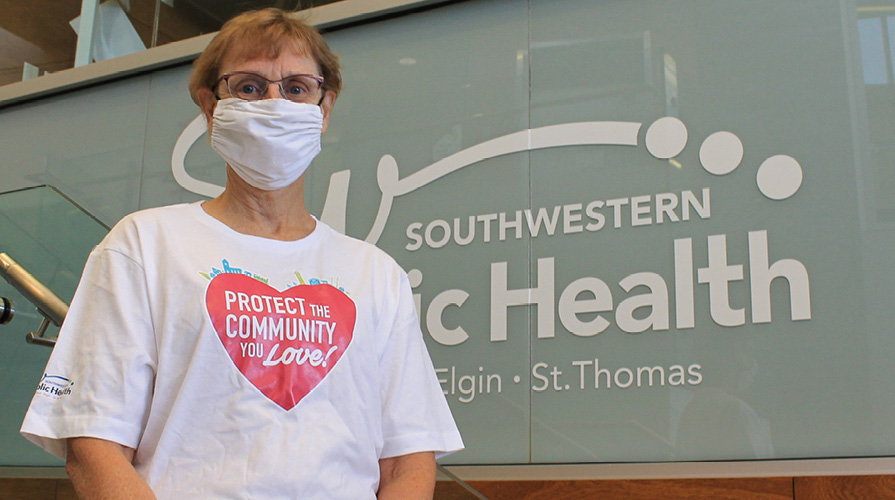This article originally appeared in the Spring 2022 issue of the Ontario Medical Review magazine.
Strengthening the public health system requires increased investment and more efficient sharing of information
The debilitating COVID-19 crisis demonstrated the resilience of Ontario’s public health system. It also exposed some notable weaknesses that have yet to be fully addressed.
When the then-mysterious coronavirus began spreading through the province in early 2020, the ranks of public health staff had been depleted amid budget constraints and Ontario’s medical information systems were disconnected, said Dr. Michael Finkelstein, a public health and preventive medicine specialist.
 This slowed decision-making. There wasn’t even an updated standardized provincial pandemic plan spelling out how all the key government agencies and private players should co-ordinate their response.
This slowed decision-making. There wasn’t even an updated standardized provincial pandemic plan spelling out how all the key government agencies and private players should co-ordinate their response.
“There was a plan, but it was for (an) influenza pandemic, and it was five or six years old,” said Dr. Finkelstein, immediate past chair of the Ontario Medical Association’s Section of Public Health Physicians.
Officials were forced to scramble to address gaps in the public health network while handling the largest public health emergency in generations. He said the shortcomings included a dearth of expertise in the emerging field of data visualization, where large sets of data and metrics are translated into more easily understood charts and graphs.
Luckily, Ontario already had well-qualified medical officers of health in place across most of the province, with the expertise and latitude to respond to local priorities. Now, with COVID-19 vaccination rates in the province well above 80 per cent and a provincial election approaching, public health officials are looking at what still needs to be done.
“Funding is essential so the public health system has the surge capacity, the plans and the connections to other parts of the system to swing into action when we have these rare, earth-shattering, economy-stopping events,” Dr. Finkelstein said.
It’s easy to overlook the public health network when everything is running smoothly. When there’s no crisis, the system provides routine services ranging from overseeing prenatal classes and childhood vaccinations to inspecting restaurants, keeping the water supply safe and backstopping mental health programs. The better the system works, the less it gets noticed. Public health leaders, for instance, get little praise when there’s no measles outbreak — and a lot of grief when there is one.
“Public health is what we do as a community collectively to ensure the health and wellness of everybody,” said Dr. Paul Roumeliotis, medical officer of health and CEO for the Eastern Ontario Health Unit, one of 34 such agencies in the province. “In general, it means a collaboration, but it also boils down to the three Ps: protection, prevention and promotion.”
Photo: Public health and preventive medicine specialist Dr. Michael Finkelstein says pandemic preparedness starts with provincial planning and equitable support of all health-care systems throughout Ontario.
In October, the OMA unveiled recommendations to address roadblocks to improving Ontario’s health-care system, based on the largest consultation in the organization’s history. Prescription for Ontario: Doctors’ 5-Point Plan for Better Health Care serves as a blueprint to improve the delivery of all health care in the province. The OMA, which represents 43,000 Ontario doctors and advocates for the health of Ontarians, hopes all political parties will adopt the blueprint’s recommendations in their platforms leading up to the 2022 provincial election.
 One set of priorities it identifies is strengthening public health and pandemic preparedness. The OMA wants Ontario to build on the current strengths of its public health system by ensuring increased investment and timely and more efficient sharing of information across health system sectors.
One set of priorities it identifies is strengthening public health and pandemic preparedness. The OMA wants Ontario to build on the current strengths of its public health system by ensuring increased investment and timely and more efficient sharing of information across health system sectors.
While strengthening the overall public health system is crucial, Dr. Roumeliotis stresses the importance of maintaining local public health so that programs can be tapered to local needs in such a large and heterogeneous province where one size does not fit all.
Among the OMA plan’s recommendations is an appeal to improve health information systems to better collect, analyze and share key medical data, and a call for a central patient information database doctors can monitor in real time.
For instance, Dr. Finkelstein would like to see a system where key, anonymized elements of patient information is collected by hospitals and community-based doctors and put into their electronic medical record systems, then it automatically flows into a central database that public health officials can query when they are looking for trends or tracking outbreaks.
When the pandemic hit, “we spent too much time trying to fix the pipes and collecting and analyzing data,” Dr. Finkelstein said of the lack of co-ordination in the province’s medical information-gathering systems.
One positive achievement was COVaxON, which Ontario developed as an integrated system for all COVID-19 vaccination information. Any health-care provider, pharmacist or public health unit administering the vaccine inputs the details into that one system. “So, at the touch of a button, I know how many vaccines were given in my area,” said Dr. Roumeliotis, who has headed the health unit in the eastern corner of Ontario since 2007.
That’s not the case with other immunization programs, where records don’t automatically flow into one database. Dr. Roumeliotis says in the past, his office has had to call other doctors and ask them to fax over proof of their patients’ shots.
“That’s archaic. There has to be interconnectivity. There’s a lot of databases there but they don’t talk to each other.”
Photo: Dr. Paul Roumeliotis, medical officer of health and CEO for the Eastern Ontario Health Unit, stresses the importance of adequate funding to both maintain and strengthen local public health programs in preparation for another pandemic.
Another issue that needs to be addressed is the lack of a standardized pandemic plan across the province’s 34 public health units. The OMA is calling for a common plan, but one that is sufficiently flexible to account for differences and inequities across the province’s diverse regions.
Dr. Finkelstein, who has held various roles at Toronto Public Health since 2001, said each public health unit currently sets its own priorities. What is needed is a provincial planning document that sets out a common set of assumptions so that when the next pandemic hits, all parts of the system are “starting at the same place.” He says the overall plan was updated during the COVID pandemic but now the province needs to regularly update that framework.
Dr. Joyce Lock, the medical officer of health for Southwestern Public Health, said her health unit in a largely rural area south of London was prepared when COVID hit.
“We had a pandemic plan, which we could reference, we had an emergency management approach, which we harnessed, and we were able to put that into gear really quickly.”
Co-ordinating with other players in the province’s health-care network was more problematic.
The government started consolidating a number of local and provincial health groups into one large co-ordinating agency, Ontario Health, at the end of 2019. Because of organization was in its infancy, it wasn’t fully ready to respond quickly to the COVID outbreak and co-ordinate action between key decision-makers across the health-care system, said Dr. Lock.
“We had a pandemic plan, which we could reference, we had an emergency management approach, which we harnessed, and we were able to put that into gear really quickly.”
—Dr. Joyce Lock
The other challenge was that the health-care system was unable to provide enough key equipment, such as personal protective equipment for health workers or testing kits, at the start of the pandemic.
That touches on a third area of concern: resourcing for Public Health Ontario. This agency provides scientific and technical advice to public health and government leaders as well as universities and community and private-sector organizations. Prescription for Ontario outlines that Public Health Ontario needs to be a robust central scientific and laboratory resource during a public health emergency, with increased funding to hire a sufficient number of public health specialist physicians to meet its mandate.
 That was not the case at the beginning of the pandemic.
That was not the case at the beginning of the pandemic.
Public Health Ontario’s budget hadn’t increased significantly for five years. Dr. Finkelstein said that left the agency without sufficient resources to deal with the full brunt of the pandemic or contingency plans to scale up quickly to respond to the COVID-19 crisis.
“They need to be funded adequately to be able to do their day-to-day function and to have the surge capacity in case there’s another pandemic,” said Dr. Roumeliotis.
Dr. Lock acknowledges the extraordinary strain the global pandemic has put on the health system — and its extraordinary response. She points to the huge ramp-up of COVID testing during the fast-evolving crisis, a process she likens to “building the plane while you were flying it.”
While ensuring quick information sharing and co-ordination among health services are important during a public health crisis, Dr. Lock said co-operation between her local health network and government and business leaders was also crucial during the COVID crisis.
“Pandemic planning requires a multi-jurisdictional approach.”
Photo: Dr. Joyce Lock, medical officer of health for Southwestern Public Health, recognizes that co-operation across health-care sectors and regions is crucial when both planning for and experiencing a pandemic.
Steven Frank is a Toronto-based writer.